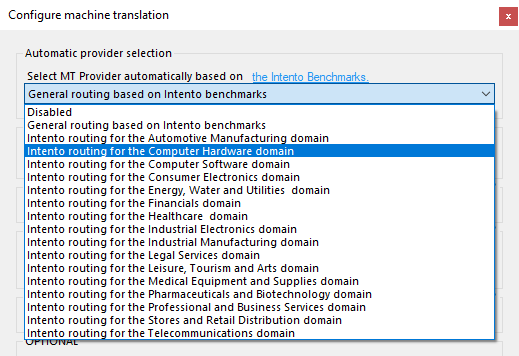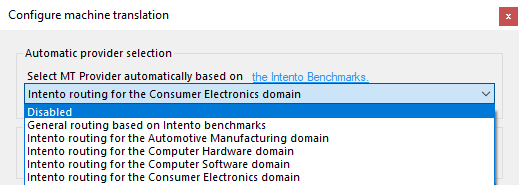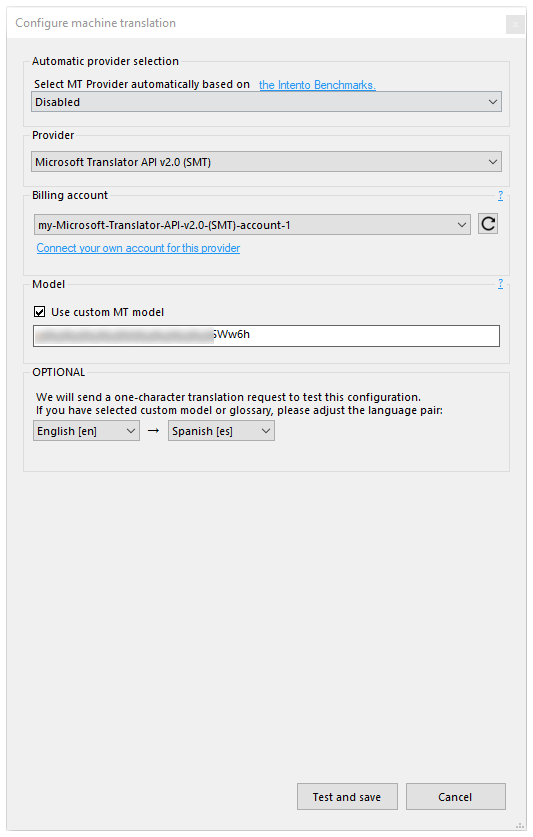Intento plugin settings
Intento is a machine translation service aggregator. It offers more than 25 services from different MT providers including Amazon, Baidu, DeepL, Google, and Microsoft (see the complete list below). Use this plugin to set up Intento's services in memoQ.
-
Alibaba Cloud (E-commerce and General Edition)
-
Amazon (Translate and Document Translate)
-
Anthropic (Claude 2, 3, and 3.5 models)
-
Baidu
-
CloudTranslation
-
DeepL (v1 and v2)
-
Elia Elhuyar
-
Globalese
-
Google Cloud Adaptive Translation
-
Google Cloud Advanced Translation API
-
Google Cloud Basic Translation API
-
Google Cloud Vertex models
-
Google Cloud Vertex via Gemini models
-
Google Cloud Vertex via PaLM 2 models
-
GTCOM Yeecloud Machine Translation API
-
IBM Watson v3
-
Kakao Developers
-
Kawamura International NMT powered by NICT
-
Kingsoft AIDAtrans Translation API
-
Microsoft Azure OpenAI MT via ChatGPT 3.5-turbo
-
Microsoft Azure OpenAI MT via custom model
-
Microsoft Translator v3 (neural MT)
-
Mirai Translator
-
ModernMT Human-in-the-loop
-
Naver Cloud WEB API
-
Naver Papago NMT (API & Commercial)
-
NiuTrans Xiaoniu Translation Cloud Platform
-
OpenAI MT via GPT-3.5-Turbo
-
OpenAI MT via GPT-4
-
OpenAI MT via GPT-4 Turbo
-
OpenAI MT via GPT-4o
-
OpenAI MT via GPT-4o-mini
-
OpenAI MT with custom model
-
Oracle Cloud Language Service
-
Prompsit Translate API
-
PROMT Cloud API
-
RoyalFlush Translate
-
Rozetta T-400
-
RWS Language Weaver API
-
SAP Document Translation
-
SAP Translation Hub
-
SDL Language Cloud Translation Toolkit
-
smartMATE Translate
-
SYSTRAN Translate Pro
-
Tencent Cloud TMT API
-
Tilde MT API
-
Ubiqus NMT
-
XL8 MT
-
Yandex Cloud Translate API v2
-
Youdao Cloud Translation
How to get here
-
At the top of the memoQ window, click the Resource console
 icon. The Resource console window opens.
icon. The Resource console window opens. -
In the Server URL list, choose or type the server's address.
To see local resources only, choose My computer, and click the Select
 button.
button. -
In the left-side pane, click the MT settings
 icon. The MT settings pane opens.
icon. The MT settings pane opens.If you have projects with more than one target language, in the top-right corner, choose a language from the Target language dropdown list.
If you want to use the same MT settings for all target languages, don't change the default value (All languages).
-
Select the MT settings resource and click Edit under the list.
-
On the Services tab, find the plugin and click its row.
-
If it's active, click its row to open the Intento plugin settings window.
-
If it's grayed out, click its row once to turn it on, then click it again to open the settings.
-

To start using MT providers, set up the plugin:
-
Get access to the service: Register at https://console.inten.to, and get an API key.
If you have a subscription to one or more MT services, you can connect them to your Intento account. Then you can use them via the Intento MT plugin.
-
Click the Enter your API key button.
-
In the Intento API key box, paste the API key.
-
To confirm: Click the Test and save button. If the key is valid, the Change MT settings button becomes available.
At this point, other fields can't be manually edited.
What can you do?
By default, Intento chooses the best service for your content, not considering what the content is about ("Smart Routing"). To use a domain-specific routing instead:
-
Click the Change MT settings button. The Configure machine translation window opens.
Built-in help: To learn more about certain parts of this window, click the question mark
 icons.
icons. -
In the Select MT provider automatically based on the Intento Benchmarks dropdown, choose a domain-specific option.

At this point, the Provider dropdown is grayed out.
-
Click the Test and save button. Intento will manage all the services, and you will pay Intento for using machine translation services.
This setting sends data to more than one MT provider: Intento regularly evaluates MT providers. When you use this setting, the Intento plugin sends the source segments to a few MT services (chosen based on the latest evaluation), and chooses the best service for the language pair you are using.
If you want to choose your MT provider on your own and don't want to use Intento's routing:
-
Click the Change MT settings button. The Configure machine translation window opens.
-
In the Select MT provider automatically based on the Intento Benchmarks dropdown, choose Disabled.

At this point, the Provider dropdown becomes available.
From here you can:
If you don't have a subscription to the MT service, you will pay Intento for using it.
- In the Provider dropdown, choose an MT service.
- In the Billing account dropdown, choose via Intento.
- If the MT service has any settings, those appear under the Billing account field. Set these as needed.
- To confirm: Click the Test and save button.
If you have a subscription to one or more MT services, you can set those up in the Intento plugin. This way, you will pay each service provider separately.
-
In the Provider dropdown, choose an MT service.
-
In the Billing account region, click the link under the account selector dropdown.
The Intento console website opens in a browser. Sign in, and connect the MT services.
-
To refresh the account list for this service: Click the Refresh
 button.
button. -
In the account selector dropdown, click the account you need.
-
If the selected MT service has any settings, those appear after the Billing account region. Set these as needed.
-
To confirm: Click the Test and save button.
If you have more than one subscription, repeat the above steps as needed.
If an MT service allows using custom engines, you can set them up like this:
-
In the Configure machine translation window's Model region, select the Use custom MT model checkbox.
-
Copy and paste your custom engine's ID text into the text field. If you see a dropdown here, you can also choose an existing engine.

You do not need your own account for this: You can use custom models without subscribing to MT providers. Just choose the via Intento billing account from the dropdown.
If an MT service provider allows it, you can add custom glossaries and customize MT with your terminology.

Intento Glossaries work in a provider-agnostic fashion. The terminology can be applied from providers that natively support terminology and those that do not have this feature yet.
Intento allows using glossaries with some MT services - so that you can apply your terminology with MT services that don't natively support terminology (and some that do). You need to add such glossaries in the Intento Console.
To learn more: Read about Intento Glossaries and supported MT providers.
Using a proxy server may help protecting your privacy. To access Intento's service via a proxy server:
- At the bottom of the Intento plugin settings window, click the Advanced button.
- In the Advanced settings window, select the Enable proxy server checkbox.
- Enter the proxy server's name or IP address, then the port number.
- To set a user name and password for the proxy server, check the Authorization required checkbox, and fill in the two text boxes.
- To confirm: Click the Save button.
Normally, Intento does not store your source or target text after translation. This can make troubleshooting difficult. If you turn on logging for a time, Intento support can check your problem more easily. To do this:
- At the bottom of the Intento plugin settings window, click the Advanced button.
- In the Advanced settings window, select the Log translation text for 30 minutes checkbox.
- To confirm: Click the Save button.
Intento will not use your texts for any other purpose, and they will delete them in a month. Still, check with your customer if you are allowed to send text samples.
When you finish
To save the settings and return to the Default resources tab of the Options window (or to the Resource console): Click OK, then click OK again.
To return to the Default resources tab of the Options window (or to the Resource console), without saving the new settings: Click Cancel, then click Cancel again.
To use the MT output in the translation editor:
- Open a project with a supported language pair.
- On the left side of the Project home or memoQ online project screen, click Settings.
- In the top bar, click the MT settings
 icon.
icon. - Choose the MT profile in the project, or one you want to add to the project. Below the list, click Edit.
- On the Services tab of the Edit machine translation settings window, check the plugin's checkbox on the left.
- On the Settings tab of the Edit machine translation settings window, in the Translation results area, choose a setting other than Off.
-
To improve the MT service by sending your translations to them: In the Self-learning MT dropdown, select the plugin.
Check your contracts first: Only do this if your data protection, confidentiality, or non-disclosure agreements allow it.
- Open a document for editing, and see the machine-translated suggestions.
To use the MT output in pre-translation:
- Open a project with a supported language pair.
- On the left side of the Project home or memoQ online project screen, click Settings.
- In the top bar, click the MT settings
 icon.
icon. - Choose the MT settings resource in the project, or one you want to add to the project. Below the list, click Edit.
- On the Services tab of the Edit machine translation settings window, check the plugin's checkbox on the left.
- On the Settings tab of the Edit machine translation settings window, select the plugin from the Pre-translation dropdown.
- Run Pre-translate. In the Pre-translate and statistics window, select the Use machine translation if there is no TM match checkbox. (memoQ will remember this.)